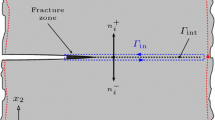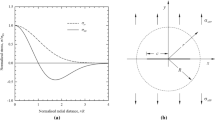Abstract
Stress intensity factors (SIFs) are computed by the boundary element method for standard compact tension specimens. Traction singular elements are employed along the crack front which enable SIFs not only to be extrapolated from crack opening displacements but also to be directly obtained as problem unknowns. Both straight and curved crack fronts are analyzed: the latter are taken to be in the form of circular arcs with curvature radii ranging from 3.145 to 0.707 the specimen thickness. The influence of Poisson's ratio on the stress intensity factor distribution is also investigated.
Résumé
On calcule les facteurs d'intensité des contraintes pour les éprouvettes normalisées de traction compactes par un méthode d'analyse d'éléments aux limites. Le long du front de fissure, on utilise des éléments singuliers en traction, ce qui permet non seulement d'extrapoler les facteurs d'intensité des contraintes à partir des déplacements d'ouverture de la fissure, mais aussi de les obtenir directement en tant qu'inconnues du problème. On analyse aussi bien les fronts de fissure droits que courbes, ces derniers étant considérés comme des arcs de cercle dont le rayon varie entre 0.3145 et 0.707 fois l'épaisseur de l'éprouvette. On étudie également l'influence du modèle de Poisson sur la distribution du facteur d'intensité des contraintes.
Similar content being viewed by others
References
H.G. DeLorenzi, Computer and Structure 13 (1981) 613–621.
M. Kuna, International Journal of Fracture 19 (1982) R63–67.
J.M. Bloom and D.B. Van Fossen, International Journal of Fracture 12 (1976) RCR 161–163.
K. Kathiresan, Ph.D. dissertation, Georgia Institute of Technology, Atlanta (1976).
A.A. Tseng and J.T. Berry, Nuclear Engineering and Design 54 (1979) 91–95.
T.H.H. Pian and K. Moriya, in Numerical Methods in Applied Mechanics, Swansea University Press, Swansea, UK (1978) 363–373.
D.M. Tracey, Nuclear Engineering and Design 26 (1974) 282–290.
W.S. Blackburn and T.K. Hellen, International Journal of Fracture 16 (1980) 411–429.
I.S. Raju and J.C. Newman, Three-Dimensional Finite Element Analysis of Finite Thickness Fracture Specimens, NASA Technical Note D-8414 (1977).
D.N. Fenner and M.J. Abdul Mihsein, International Journal of Fracture 25 (1984) 121–131.
O.L. Towers and A.P. Smith, International Journal of Fracture 25 (1984) R43-R48.
A.P. Smith, O.L. Towers and I.J. Smith, in Proceeding of 3rd International Conference on Numerical Methods in Fracture Mechanics, Swansea (1984) 205–221.
K.H. Lee, The Effect of Crack Front Curvature on Stress Intensity Factor in Compact Tension Specimens Using the Boundary Integral Equation Methods, The Welding Institute, Abington, Cambridgeshire, England, (July 1979).
Y. Yamamoto and Y. Sumi, International Journal of Fracture 14 (1978) 17–38.
G. Yagawa and T. Nishioka, International Journal for Numerical Methods in Engineering 12 (1978) 1295–1310.
J. Alam and A. Mendelson, International Journal of Fracture 23 (1983) 317–324.
J.J. McGowan, in Proceedings of X Southeastern Conference on Theoretical and Applied Mechanics (1980) 415–433.
M.A. Schroedl and C.W. Smith, in Fracture Mechanics, ASTM STP 560, (1973) 69–80.
D.B. Barker and M.E. Fourney, Experimental Mechanics 17 (1977) 241–247.
E.S. Folias, International Journal of Fracture 16 (1980) 335–348.
J.P. Benthem, International Journal of Solids and Structures 13 (1977) 479–492.
Z.P. Bažant and L.F. Estenssoro, International Journal of Solids and Structures 17 (1979) 405–426.
J.S. Solecki and J.L. Swedlow, in Fracture Mechanics: Sixteenth Symposium, ASTM STP 868, M.F. Kanninen and A.T. Hopper (eds.), American Society for Testing and Materials, Philadelphia (1985) 535–553.
C.L. Tan and R.T. Fenner, Proceedings of the Royal Society of London A 369 (1979) 243–260.
M.L. Luchi and A. Poggialini, in Proceedings of the 5th International Conference on Boundary Elements, Hiroshima, Japan (1983) 461–470.
T.A. Cruse, International Journal of Solids and Structures 5 (1969) 1259–1274.
F.J. Rizzo, Quarterly of Applied Mathematics 25 (1967) 83–95.
C.A. Brebbia, The Boundary Element Method for Engineers, Pentech Press, London (1978).
J.C. Lachat and J.O. Watson, International Journal for Numerical Methods in Engineering 10 (1976) 991–1005.
E399-83, Standard Test Method for Plane-Strain Fracture Toughness of Metallic Materials, Annual Book of ASTM Standards (1983).
M.L. Luchi and S. Rizzuti, International Journal for Numerical Methods in Engineering, to appear.
J. Eftis, N. Subramonian and H. Liebowitz, Engineering Fracture Mechanics (1977) 189–210.
T.A. Cruse, International Journal of Fracture Mechanics 6 (1970) RCR 326–328.
O.L. Towers, Journal of Testing and Evaluation 11 (1983) 34–45.
Author information
Authors and Affiliations
Rights and permissions
About this article
Cite this article
Luchi, M.L., Rizzuti, S. Boundary element analysis of CT specimens with straight and curved crack fronts. Int J Fract 34, 23–40 (1987). https://doi.org/10.1007/BF00042122
Received:
Accepted:
Issue Date:
DOI: https://doi.org/10.1007/BF00042122




